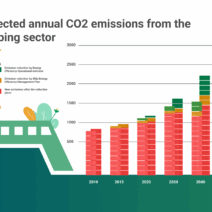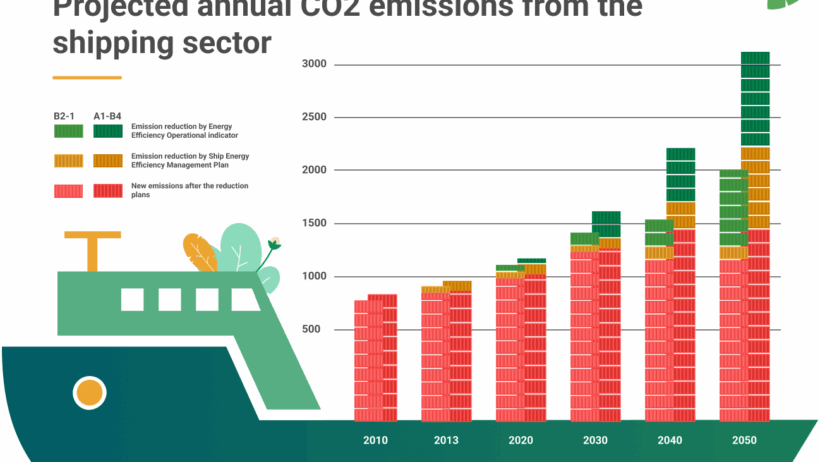In the ongoing discourse surrounding global warming, transportation remains a pivotal sector contributing to greenhouse gas emissions. Within this sector, a dichotomy often surfaces between shipping and automobile transportation. This prompts a critical question: does shipping outpace cars in terms of global warming impact? To understand this issue comprehensively, one must explore the emissions profile of each mode of transport, the nuances of their operational contexts, and the broader implications on climate change.
Understanding Emissions Profiles
To effectively compare the two, we first consider the emissions profiles. Shipping, often perceived as a more environmentally friendly alternative to land transport, is not without its burdens. Ships predominantly operate on heavy fuel oil, which emits substantial amounts of carbon dioxide (CO2) and other pollutants during combustion. In fact, according to various studies, the shipping industry accounts for approximately 2-3% of global CO2 emissions, a figure that parallels some of the world’s largest polluters.
Conversely, cars emit CO2 as well, but the emissions vary significantly based on factors such as fuel type, engine efficiency, and usage patterns. The automotive sector is estimated to contribute around 12% of total global CO2 emissions, a stark reminder of the environmental impact of personal and commercial vehicles. Nevertheless, this seeming disparity is complicated by the scale and nature of each sector’s operations.
Operational Scale
The operational scale of shipping vastly differs from that of car transportation. Container ships can carry thousands of tonnes of cargo across vast distances while utilizing relatively lower fuel per ton-mile compared to trucks and cars. However, the sheer volume of goods transported globally by sea means that the aggregate emissions become significant when looked at from a macro perspective. This raises an intriguing point: while individual cargo ships may emit less CO2 on a per-unit basis, the cumulative impact of extensive shipping activities contributes significantly to global warming.
On the other hand, cars are much more ubiquitous. With billions in operation worldwide, the cumulative emissions from automobiles can exceed those from the shipping industry despite their more efficient per-mile emissions profile. The diversity of vehicle types, from electric cars to gas-guzzlers, further complicates the metrics by which we assess their environmental impact.
Pollutant Diversity and Regional Discrepancies
Another critical aspect to consider is the diversity of pollutants. Shipping contributes not only CO2 but also sulfur oxides (SOx), nitrogen oxides (NOx), and particulate matter, all of which pose severe health risks and contribute to other environmental problems such as ocean acidification and smog formation. The International Maritime Organization (IMO) has recognized these implications and implemented regulations aimed at reducing sulfur emissions, but enforcement and compliance remain challenges.
In contrast, automobiles primarily emit CO2 alongside smaller quantities of NOx and volatile organic compounds (VOCs). While the immediate local air quality issues generated by vehicles are catastrophic, shipping emissions are often dispersed across broader areas, complicating the attribution of health impacts to specific sources. This geographic dissociation complicates policy-making efforts and diminishes the urgency associated with reforming shipping practices as compared to road transport.
Technological Advancements and Future Trends
As the global community intensifies efforts to combat climate change, both the automotive and shipping industries are experiencing transformative technological advancements. The rise of electric vehicles (EVs) presents substantial potential to mitigate the automotive sector’s environmental footprint significantly. Automakers are racing to innovate, with increasing investments in battery technologies and charging infrastructure. The transformation is palpable, as some nations promote or mandate the adoption of electric vehicles to reduce reliance on fossil fuels.
Shipping, however, has faced more formidable obstacles in transitioning to greener alternatives due to its size and operational intricacies. While solutions such as liquefied natural gas (LNG), hydrogen fuel cells, and wind-assisted propulsion are under exploration, the shift is neither as swift nor as straightforward as in the automotive sector. The reluctance to retrofit older vessels and the high initial costs associated with new technologies have slowed progress. Therefore, the stagnation in shipping innovations exacerbates its potential for long-term sustainability.
Policy Implications and Global Cooperation
The comparative emissions from shipping and cars prompt serious consideration of policy implications. Tackling these issues on a global scale requires unprecedented cooperation among nations to implement regulations that effectively reduce emissions from both sectors. The Paris Agreement has established a framework for emissions reduction, but translating commitments into actions remains challenging. International shipping presents unique challenges due to its transboundary nature, which necessitates collaborative solutions that are often hampered by national interests.
Conclusion: A Complex Interplay
In conclusion, the quest to determine whether shipping outpaces cars in global warming impact reveals a complex interplay of factors, including emissions profiles, operational scales, pollutant diversity, technological advancements, and policy implications. While shipping may emit less CO2 on a per-unit basis, its collective impact, combined with the significant pollution it generates, underscores its critical role in the climate crisis. Conversely, the sprawling emissions from the automotive sector illustrate the pressing need for transition toward sustainable practices. Only through comprehensive strategies that embrace innovation and international cooperation can meaningful progress be achieved in the fight against climate change.






